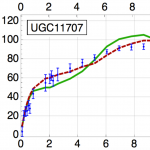Paper of the month: Emergent gravity in galaxies and in the Solar System

March 23, 2017 by RebecaBV
A number of observations and theoretical insights suggest that the theory of general relativity (GR) may not be correct at all scales. On one hand, most of the Universe we observe may be filled with mysterious forms of energy and matter. On the other, hints from black hole physics and quantum gravity theories such as string theory point to a very different description of spacetime to current models. In this context, the notion of emergent spacetime has been proposed [1; 2], its principles based on black hole thermodynamics and quantum information theory.
Figure 1

Caption: Artist representation of the entanglement of the microscopic quantum states. From Ref. [2]
In EG, spacetime appears as an effective representation of the entanglement structure of the underlying quantum state. The theory predicts an interplay between the surface contribution to the entanglement entropy, which produces GR-like gravitation, and the volume contribution, which explains dark energy and dark matter. The central idea is that the bulk contribution of the entanglement entropy is associated with dark energy, which makes spacetime behave as an elastic medium. Then the elastic response of the medium to the presence of matter is seen as an extra gravitational force, which mimics the effect of dark matter. The model expects GR to work well because at most scales the volume entropy is negligible compared to the surface one. However, at very large scales the volume entanglement dominates, causing the deviations that are attributed to dark energy and dark matter. Verlinde gives a condition to separate the GR regime and the EG one, when the surface mass density falls below a universal value determined by the acceleration scale:
Σ(r) = M/4πr2 < cH0/8πG
Here, M is the mass enclosed inside a sphere of radius r, c is the speed of light, G is Newton’s gravitational constant and H0 is the Hubble parameter, which measures the current expansion rate of the Universe. If this condition is satisfied, deviations of EG from GR will be large, if not, GR is a good approximation of EG. This condition is satisfied, for instance, at the galactic scales, which means that the theory can be tested at these scales.
In particular, galaxies are relevant for explaining dark matter. Dark matter tries to explain a number of observed gravitational phenomena that can't be explained within the framework of GR plus the standard model of particle physics. The most successful solution is to add a new kind of particle, leaving GR untouched. However, other constructions explain the discrepancies by modifying the laws of GR instead of predicting new particles. Verlinde’s approach fits into the second category, proposing that the dark matter problem could naturally be addressed in the context of EG.
Hees et al. [3] have very recently compared some observed galactic rotation curves to what would be expected from EG. Rotation curves describe how the velocity of matter in galaxies depends on its distance from the centre ([4], [5]). They are one of the most compelling pieces of evidence for dark matter, and therefore an important test of EG. Although galaxies are radially symmetric while EG relies on spherical symmetry, this should not influence the results much, indeed Verlinde himself focused on galaxies by showing that EG can explain the relationship between their luminosity and velocity. Using the measured Hubble rate, the authors find that EG is inconsistent with rotation curve data. Their important caveats are that the Hubble rate measurements themselves could be affected by EG, and that there could be an external field that affects gravity, a feature of modified gravity models. Hees et al. find that EG is more likely when these factors are considered, but the theory remains disfavoured compared to other models.
The main reason why EG does not fit the data well is that Verlinde’s description of the elastic response of spacetime to nearby matter is an integral equation. Consequently, the acceleration equation which enters the rotation curve formula features a derivative, and this leads to wiggles in the rotation curve predictions which are not observed in galaxy rotation measurements. A clear example of the wiggles is shown in Figure 2.
Figure 2

Caption: Comparison of rotation curves for one of the galaxies used in [3]. The x-axis is the radius in kpc, the y-axis is rotation velocity in km/s.
Observational data, with error bars, is in blue, the MOND fit is the red dashed-line and the EG prediction is depicted by the green curve. Note the pronounced wiggle. From Ref. [3].
The authors also study planetary orbits around our Sun, claiming that the data rules out EG entirely. However, this study is carried out at a scale where the new formulas of EG are in principle not valid, cf. Equation (1). Nevertheless, the analysis of rotation curves, done also in e.g. [6], is already an important criticism of the EG paradigm.
Emergent gravity is an exciting and fresh attempt to connect gravity and quantum information theory to the dark universe. But it is already facing some significant observational challenges.
Text by Gonzalo Alonso and Rupert Coy
Bibliography
[1] M. van Raamsdonk, Building up spacetime with quantum entanglement, arXiv:
1005.3035 [hep-th].
[2] E. Verlinde, Emergent Gravity and the Dark Universe, arXiv:1611.02269 [hep-th].
[3] A. Hees et al, Emergent gravity in galaxies and in the Solar System,
arXiv:1702.04358 [hep-ph].
[4] J. Gehrlein, The Radial Acceleration Relation in Rotationally Supported Galaxies,
Elusives Paper of the Month, November 2016.
[5] E. Perdomo & J. Stadler, Search for annihilating dark matter in the Sun with 3
years of IceCube data, Elusives Paper of the Month, January 2017.
[6] F. Lelli et al, Testing Verlinde’s Emergent Gravity with the Radial Acceleration
Relation, arXiv:1702.04355 [hep-ph].


